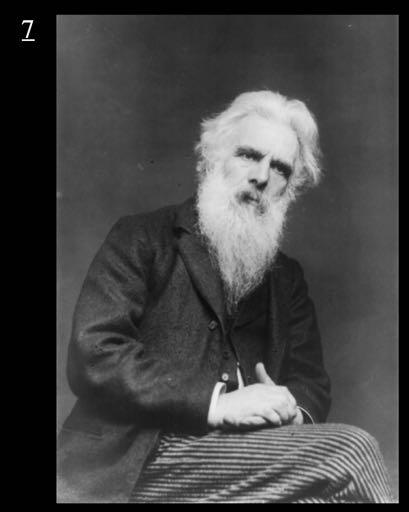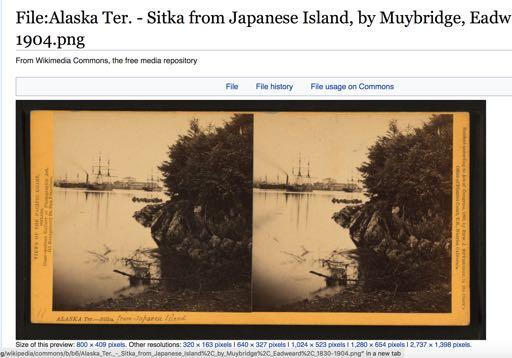
7 minute read
EADWEARD MUYBRIDGE
Eadweard Muybridge in Alaska
Advertisement

In the summer of 1868, only a year after the purchase of Alaska from Russia and barely six months after the transfer ceremony was held in Sitka, reknowned photographer Eadweard Muybridge was hired to take photographs of the new land known as the Department of Alaska. In a direct Army commission, Muybridge was charged to “gather information about the commercial value and strategic usefulness of the territory.” He would conduct his photography during an expedition led by Major-General Henry W. Halleck, commander of the U.S. Military Division of the Pacific, who had been a prominent Union general in the Civil War, a pallbearer at President Lincoln’s funeral, and is credited as one of the people who gave Alaska— then known only as Russian America—its name.
Eccentric and mysterious, Eadweard Muybridge was an English-American photographer who had nonetheless garnered widespread acclaim for his pioneering work in grand photographic studies of landscapes, and he would later become famous for his early work in motion-picture projection. His 1868 photographs taken at Fort Tongass, Fort Wrangle (later Wrangell), and Sitka were the first photographs of Alaska to be widely seen by the general public.
Muybridge published 39 stereogram views of Southeast Alaska, that is, two side-by-side photographs taken simultaneously with a single camera, which, when seen through a viewing device called a stereoscope, merge into a single three-dimensional image. Think of the children’s version known as a Viewmaster, with its round cards of twin slideviews. This was cutting-edge technology in the 1860s, and Muybridge was an acknowledged master of the craft.
He was born in the ancient town of Kingston-On-Thames, England, on April 9, 1830, to a coal merchant and his wife, John and Susan Muggeridge, and they named him Edward James Muggeridge. In 1852, at the age of 22, he emigrated to New York on the SS Liverpool to work as a publisher's agent, and began a bookselling partnership with a Mr. Bartlett. Three years later he
March-April 2020 moved to San Francisco, where he continued with the publishing company while also opening another successful bookstore. Advertisements of the day in the San Francisco Daily Evening Bulletin noted he offered “Books imported to order from New York, London, and Paris on commission, at publishers’ prices.”
In June, 1860, shortly before a trip east, Muygridge (as he was then spelling his surname) advertised in the same paper, stating he’d sold his bookstore and was: “…happy in receiving any commissions my friends may entrust me with for the purchase of books, engravings, or works of art.”
On July 5th he boarded a Butterfield Overland Stage coach, bound for the eastern U.S., but near Fort Worth, Texas, the stagecoach left the road and tumbled down the rocky side of a mountain, killing one passenger, injuring several others, and leaving Muygridge unconscious. He woke up 150 miles away, in Fort Smith, Arkansas, where a doctor told him he would never fully recover. When Muygridge could travel again he resumed his trip to England for medical attention and spent the next six years recuperating there. He took up professional photography before going back to San Francisco in 1867 with the finest photographic equipment of the day. He returned with a new career, landscape photography, a new spelling of his name and a new pseudonym, “Helios” (Titan of the Sun), which he used on occasion.
In the spring of 1867 Muybridge successfully photographed the magnificent granite monoliths and inspiring thousand-foot waterfalls of Yosemite Valley, photographs which made him world-famous and would later inspire the work of Ansel Adams. Muybridge’s photographs were innovative and technically excellent, and the following summer he was invited to tour Alaska with General Halleck to photographically document the nation’s newest acquisition.
The Halleck military expedition, with Muybridge aboard, departed for Alaska on July 29 aboard the steamship Pacific, arriving at Tongass Island on August 13, before moving on to Wrangle (now Wrangell) and Sitka. They would be in Alaskan waters for two weeks.
Photography was still a young technology in 1868, and cameras of the day were comprised of simple wooden boxes carefully fitted with lenses. The photographer would bathe a glass plate in a chemical solution, then immediately expose it to the subject through the lens for several seconds or even minutes; subjects which moved during that critical time could appear blurred or even disappear altogether. Negatives would then be developed in the field immediately afterward. To accomplish this, Muybridge used a horse-drawn carriage to transport his photography equipment and darkroom, a traveling workroom he called The Flying Studio.


He called himself a "photographic artist,” dressing the part by affecting the broad-brimmed hat and velvet cape of continental poets and painters. Tall and lean, with wild hair, bushy brows and a long white beard, he undoubtedly cut a striking figure at the Alaskan stops. Most of his work on the trip was photographed under his pseudodom, “Helios.”
In an article titled ‘Helios Rampant,’ a reporter on the trip colorfully wrote, “The photographic artist, ‘Helios,’ … had come to Sitka with dismal forebodings that the fog would so obscure the face of nature as to render his art valueless, but now he had struck a streak of sunshine and was determined to make pictures while it lasted. With shirt-sleeves rolled up, and hair on end, he trotted his flying studio through the town while the daylight lasted, and was enabled to get a number of excellent views.”

They are indeed excellent views, and among the first seen by the curious American public, who wondered about this new land of ice and snow and polar bears. The first stop of the SS Pacific was the newly commissioned Fort Tongass, a United States Army base on the east side of Tongass Island, in the southernmost Alaska Panhandle. Still under construction when they visited, it would be the first U. S. Army base established in Alaska following its purchase from the Russian Empire. A stereoscopic view shows a group of Native people in front of a totem pole; located adjacent to the new fort was a village of the Tlingit people.
Another stereoscopic view shows a ship in the harbor of Sitka as seen from Japonski Island (Russian for Japanese Island), named by the Russians after a group of Japanese fishermen were stranded there in 1805; the Russians returned them to their homeland the following year.

Sitka from Japanese Island, 1868
Many of Muybridges’/Helios’ photographs of Sitka showcase the magnificent St. Michael’s Cathedral, the earliest Orthodox cathedral in the New World, built in 1844-48 and an important legacy of Russian influence in North America. It became a National Historic Landmark in 1962.

A few weeks after the expedition returned, General Halleck expressed his appreciation for the photographs in a letter to Muybridge, noting: “These views, besides being beautiful works of art, give a more correct idea of Alaska, its scenery and vegetation, than can be obtained from any written description of that country.”

Fort Tongass, a group of Indians, 1868
And on June 24, 1872, The Alaska Herald noted: “Just previous to the later General Halleck's departure East, he made a tour of inspection to Alaska Territory, and, by instruction of the Secretary of War, was accompanied by our celebrated photographic artist Muybridge, who made a series of the most picturesque and valuable photographs we have ever seen. The Hon. William H. Seward thought very highly of them and addressed Mr. Muybridge a very complimentary letter in acknowledgement of his appreciation.” (Vol.V No.107 p.54)
In truth, Eadweard Muybridge’s trip to Alaska was a mere footnote in his illustrious life. He would go on to become one of the most celebrated photographers in history, developing, among many other processes and inventions, the concept of motion pictures which would later produce movies and television. He received prestigious awards and accolades and authored two books, 'The Horse in Motion' (1882) and 'The Human Figure in Motion' (1901), both still in print today. He was tried and acquitted in a controversial and widely-reported murder trial—even though he was in fact guilty of shooting his wife’s lover at point blank range, before witnesses.
'Exposing Muybridge' is a documentary film now in production by Marc Shaffer, a documentary filmmaker in Oakland, California. Shaffer notes, “The photography of Eadweard Muybridge has had a profound and enduring impact on many fields including fine art, medicine, athletics, computer generated special effects, horseracing, even industrial manufacturing and nuclear physics.”
In 1894 Muybridge returned to live out his days in his birthplace, Kingston, England, where he died of pancreatic cancer in 1904. ~•~
'Exposing Muybridge' - For information visit https://www.muybridgethemovie.com






